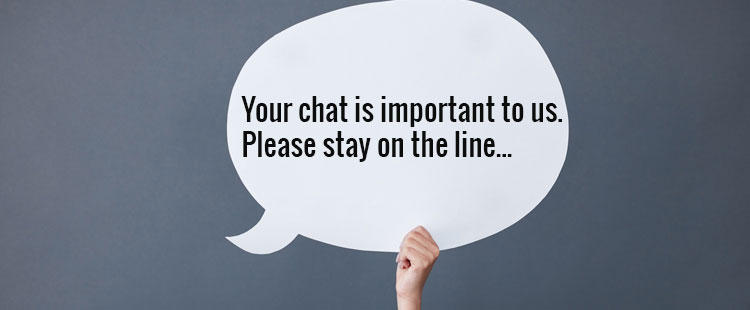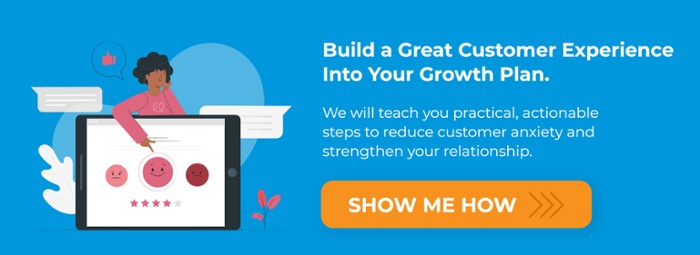
Using Chatbots to Improve Customer Experience
Patrick Dodge
Founder
Is your company using chatbots to deliver customers a great experience?
Most companies would answer yes, but if you spend a lot of time conversing with programmed apps like I do, you'd probably agree there's some work to be done.
Having worked through a few bot launches now, I've come to realize the most important thing is to frame your efforts around making things easy for the customer. Not yourself.
That was a hard lesson to learn. We marketers are always looking for ways to scale and automate things. How can I hit the “easy button” and check this off the list? That's often how the thought process goes. But this approach rarely works in our favor, especially with bots.
Just ask Dana Tran. Dana is a thought leader on Messenger bots, and someone I like to call “the world’s most reluctant marketer.” She’s the only person I know who has catapulted herself to influencer status in the community without any sort of marketing background. An IT professional by trade, Dana become fascinated with bots when they first emerged on the scene many years ago. She left the corporate world and focused on training small businesses to use bots, and since then has been featured on multiple blogs and podcasts, including Social Media Examiner.
Dana and I got together for a chat on Frictionless, and uncovered some great insights for marketers that are trying to do more with their bots than make them automated lead qualifying machines.
Chatbots Are Not Just For Lead Generation.
We often make the mistake of thinking of bots only in terms of lead generation and customer acquisition.
Email marketing doesn’t produce the returns it once did, so they just move the constant barrage of messages over to the bot because that’s where the people are. This is a huge mistake we covered in our previous post about chatbots and B2B lead generation.
How can marketers start thinking of using bots to enhance the overall customer journey?
Even though bots started to get big in the last few years, it’s still kind of like the Wild West out there. The rules are not clearly defined. But some companies are breaking out of the pack and using their bots to elevate the overall customer experience.
Lego is one example Tran points to as an example.
Lego is not the same company that existed in the 1990s. Back then you bought a standard box of pieces you could build stuff with. Now they have a hundreds of themes to choose from: Batman Legos, Marvel Legos, Star Wars, you name it.
There are so many options, it’s not always easy to know where to start when you’re looking for a gift for kids (or adults). Whatever the occasion, Lego’s bot is designed to help people find the perfect set for them.
“They have an awesome bot,” Tran says. “It asks you a series of questions about who you’re buying the product for. It’s just like you walked into a store, and a person comes up and asks, ‘How can I help you?’
“They learn more about their customers while helping them find what they need quickly. It’s a super creative, and really fun chatting with their bot. There’s no spam, which is really important. One of the worse things you can do is push people to a sale without understanding their needs.”
Lego is a fascinating example for many reasons.
Somewhere along the way, the company realized they have a core group of super-fans that are extremely passionate building things, and Lego started focusing on building that community with different themes and creative options. They’ve made their bot into an extension of that community experience.
“They’re using it as tool to guide people and learn more about them, not to close the sale,” Tran says. “Nobody likes a company that treats you like royalty right up until the moment you pay, and then they disappear off the face of the earth. So why do so many companies do that?
Why wouldn't they assume that what happens after the sale is just as important? I might buy another product or service they offer or recommending them to a friend of mine. The sales process doesn’t end when you close the deal.”
Too Much Automation, Too Fast

If you’re starting out with automation, it’s best to start small.
Automate a very basic process. For example, if you’re a SaaS company and you have a user asking what’s your pricing is, your bot can provide them the answer. There’s no harm that. But it should follow up with, “If you have any other questions, I can connect you to a human.”
The problem with automation, Trans says, is not that there’s too much of it, but that it’s going too fast. You don’t want to automate anything that requires a human being to analyze the problem and give specific, customized answers.
Be Fast and Frictionless
I recently had a rotten experience with a bot used by one of the software companies I use.
I was running into challenges and needed to chat with support. So, I messaged them on their bot.
I waited and waited, thinking that since I didn’t get an auto-response I must be in que to talk to somebody. Almost fifteen minutes went by, and I got an automated message saying no one was available. They gave me an email address to contact support with.
There are several things they did wrong here. First, they made me wait an eternity to get their auto-response (yes, a few minutes is an eternity today). The second missed opportunity is not offering to contact me. Instead, they invited me to write an email to their support team.
Think about the state of mind I was in when this situation occurred. I had spent a lot of time troubleshooting a problem I couldn’t solve. I was tired and frustrated when I reached out for help. Not only did they leave me hanging on the line, they put the onus of getting help back on me.
At that point, I was so irritated I suspended my account. This might seem extreme, but keep in mind this incident came after several other bad experiences with the brand.
The lesson is to remember your bot exists to remove friction between customers and your brand. If you make people jump through hoops to speak with a live person, you may end up losing the customers instead.
Tran agrees. “It’s not what you are selling, but how you sell it. You can get almost the same product at Wal-mart as you do at Amazon, but Amazon is more convenient, and they put the customer experience first.”
Can Your Bot Do Both Service and Sales?
Tran says it’s fine to have multiple goals for your bot, but make sure that you have the bandwidth to train and monitor it first.
Referring back to my example above, the company I was working with didn’t take the time to properly train and monitor their bot, and ended up frustrating me instead of helping me.
Building a bot is not a one-time task. You build it, test it, launch it into the wild, and see how people react to it. Then, you can make modifications to improve the experience.
So, if you have multiple goals, you will need to analyze and tweak these features to make sure that they are doing well, because what’s the point of having two features that are substandard, versus one great feature?
Monitoring Performance
There aren’t many tools out there yet to help you collect data about how satisfied people are with your bot. But Tran says you can great insights just from monitoring interactions.
Are people following a sequence to the end, or dropping out somewhere? This is where you will find clues about how effective your bot is at helping people solve their problems.
You should also look at the comments people leave behind. Do they sound happy or frustrated? A little personality in your bot can go a long way. Tran says people test her bot all the time by swearing at it, and she programmed it to respond with a frowning face, saying, “That’s not very nice.” People don’t expect that, and they sometimes apologize. Little things like that can make a difference.
Another thing you can do is ask people to fill out a survey, just a short score to measure their satisfaction with the overall experience. If you really want to be helpful, follow up with an email a few days later to see if the customer’s issue got resolved. If you do that, make sure you are prepared to act quickly if they are still having problems.
Getting back to our original point -- the biggest thing to remember with chatbots is that they exist to make life easier for customers, not marketers. If you are trying to program the bot to answer every need without the assistance of a live human being, you are missing the point and will likely do more harm than good.
People don’t like talking to machines. They will put up with it for a short time, but if you make them wait too long for real service you will lose them. Think about how frustrating it is to call the cable company and have to go through a hundred menu prompts before they let you talk to a person who can help you. Bots are the same way.
There will come a day when bots are smart enough to deliver the same level of service a person can, but for now, we should all just plan on helping customers one-on-one. You know, the way we all like to be helped when we ask for it.
Mar 22, 2019 1:09:43 PM

